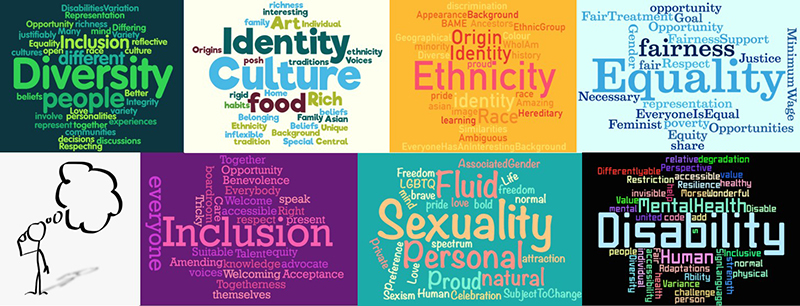Dive into diversity
Contents |
[edit] Introduction
Claudia Caravello and Kirsty L. Greener Diversity Officers of the ICE London Graduate and Student committee share their learning from a London graduates and students (G&S) meeting, with guest speakers from the Association for Black and Minority Engineers (AFBE) and the BAME Collective, on what diversity really means.
[edit] Defining diversity
What springs to your mind when you think of the word diversity? We posed this question to members in advance of our graduates and students meeting. At the beginning of the meeting we hold a diversity moment to create awareness about a particular group/section of society and how this relates to engineering.
[edit] Diving deeper
As a practical exercise, the word diversity was broken down further with associated words such as, Inclusion, Ethnicity, Disability, Sexuality, Culture and Equality. Word clouds were used as a visual representation of the thoughts and feelings associated with each word, as in the image below.
Through our discussion, ‘sexuality’ was widely recognised as being fluid, natural and something to be proud of and celebrate. Looking back on June 2020 and how the UK celebrated Pride month and the LBGT+ community, this spurred further conversations about changing public opinions and being brave about your personal choices including allyship #YouMeUsWe.
Both ‘mental health’ and ‘human’ were popular words, indicating how mental health is rising in significance and more conversations are beginning about a once-taboo topic, and that we need to be more inclusive and considerate.
Interestingly, ‘inclusion’ drew associations to the boardroom, questioning whether it's currently an inclusive place and noting the challenges involved. However, the main word that shone through was ‘everyone’, with all members agreeing that inclusion will be achieved when everyone feels welcome, comfortable and heard.
A video of the discussion can be viewed from this link.
[edit] Having visible role models is key
Leading the next discussion was Maryam Adeleke MICE, Structural Engineer at Arup and Schools Outreach Programme Manager for AFBE; and Favor Nwosu, creator of BAME Collective and Biomedical Science student from the University of Sussex.
Favor Nwosu stressed that visible role models are key to removing racial disparities in STEM. The BAME Collective was started to help increase the representation of black and minority ethnic role models.
Its website is poised to become a hub for information on role models and a facilitator of connected experiences for BAME students in STEM. The website will have opportunities for members to put themselves forward as role models, to help mentor or to provide advice to upcoming students in STEM.
AFBE studies have shown '25% of engineering students are BAME whilst they make up only around 7.8% engineering professionals.'
To tackle this problem, the AFBE run transition programmes for students helping them into engineering, with their programme finding 70% are in a relevant role within 12 months. These programmes and mentoring and mentorship programmes can be found on their website.
Maryam Adeleke MICE, Structural Engineer at Arup and Schools Outreach Programme Manager for AFBE said: "The AFBE is for everyone, so anyone can engage with - and support - our work. Members can get involved by offering to give a presentation on their career or becoming a mentor."
The AFBE aims to display the vast array of talent in the engineering industry, inspire personal and corporate development through programmes, courses and conferences. The organisation has inspired more than 4,000 young people to consider STEM.
[edit] Making small changes, professional or social, can benefit others
We should not underestimate on the difference we can make to others. Even during the word cloud exercise the word ‘disability’ was displayed in a purposefully inaccessible font that required concentration to read - highlighting how our choices can restrict others. This prompted conversations about accessibility and how small adaptations, or adjustments could make huge differences.
A great example is the ICE G&S recent Deaf Awareness Video, which illustrates how lip reading ability has reduced significantly during COVID-19. Additionally, organisations such as LinkedIn now provide accessibility functions, such as recording your name so people can understand how to pronounce it correctly, which is so important in greeting new people.
Overall it was noted that the word clouds were very positive, acknowledging challenges but also showing a willingness to change, adapt and support.
This article was originally published on the ICE Community Blog under the title, 'Dive into diversity. What do you think when you hear "engineer"?' It was written by Claudia Caravello MEng GMICE, Kirsty L. Greener MEng GMICE and posted on 7 August 2020.
--Institution of Civil Engineers
[edit] Related articles on Designing Buildings
- Articles by ICE on Designing Buildings Wiki.
- Black excellence in UK civil engineering.
- Celebrating women in engineering.
- Charter for diversity and inclusion in construction and special report launched by CIOB.
- CIAT celebrates Pride 2020.
- Diversity, equality and opportunities in the construction industry.
- Gender stereotypes examined in Unlimited Potential report.
- How to become a civil engineer.
- How to encourage women into engineering.
- Inclusivity in engineering.
- ISO 30415.








